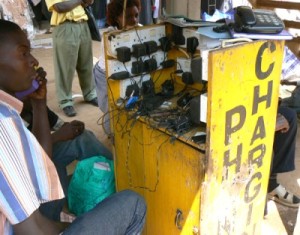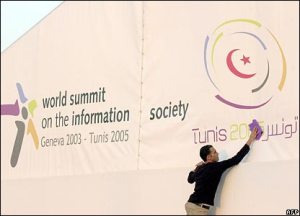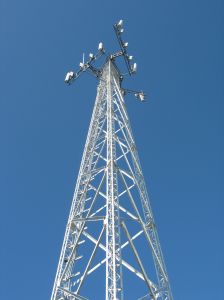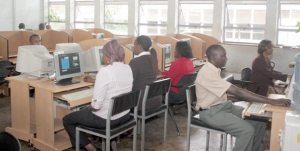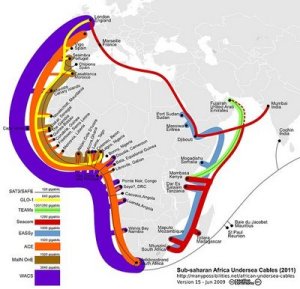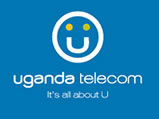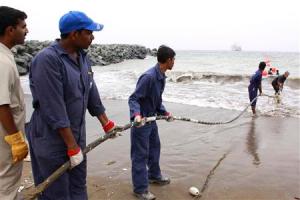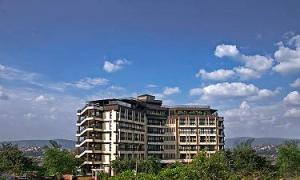• Facebook is the most popular destination among African users•Twitter is the ninth most visited internet site in South AfricaHaving swept America and conquered Europe, social networking site Facebook is now spreading rapidly through Africa.From the deserts of Libya to the plains of Tanzania•Facebook is fast becoming the continent’s most visited mobile site as Africans use their phones to access the internet, according to a new report.Even micro-blogging phenomenon Twitter is making an impact, appearing as the ninth most visited mobile internet site in South Africa and Kenya, according to a study by Oslo-based mobile software developer Opera of the top ten ‘mobile web’ countries in Africa.The most popular African destination on the mobile web, is Facebook. The social networking site is visited by users of Opera’s mobile web browser in six out of the 10 countries surveyed by the company . Google is either number one or two in every African state except Kenya where Yahoo dominates.Email services such as Hotmail and Gmail are also popular as is YouTube. The online video site has its highest rankings in Egypt, at number three, and Libya, at number four.Among news sources, the BBC figures strongly in the top ten most visited sites in Nigeria, Kenya, Ghana, Tanzania, Namibia and Zambia. CNN features prominently in the top ten in Nigeria, Ghana and Zambia. They are the only two western news sources among the most popular mobile internet destinations across the ten African countries analysed by the Opera survey.Sport features strongly with French sports newspaper L’Équipe the sixth most visited mobile web site in Ivory Coast. Egyptian mobile phone users flock to Arabic language sports portal Filgoal.com and Libyans prefer rival Koora.com.Mobile usage is ballooning across the continent and the African mobile phone market – at more than 400 million subscribers – is now larger than in North America. Some countries, such as South Africa, have ‘mobile penetration levels’ – the number of handsets compared with size of population – close to those of Western Europe.For many people in Africa, mobile telephones are the only way that they will ever get access to the internet because of the poor quality, and often complete lack, of fixed-line networks. Fierce competition has pushed mobile prices down for consumers while many of the latest crop of handsets available in Africa allow easy access to the mobile internet. Web browsers can also be installed on older phones.The mobile web browser developed by Opera is the most popular in Africa, accounting for more than half the market, and in its latest State of the Mobile Web report, Opera estimates that the number of handsets using its browser across the top ten African states has leapt 177% in the past year. The report looks at South Africa, Nigeria, Kenya, Egypt, Ghana, Libya, Ivory Coast, Zambia, Tanzania and Namibia. Opera refuses to give overall customer numbers for Africa, but in its largest market – South Africa – it had 1.5 million ‘unique users’ in October.Internet-enabled handsets are being used to access ever more mobile web sites, with page views shooting up 374% between November 2008 and last month. In some countries such as Kenya and Zambia, hundreds of pages are being accessed each month as handsets are often used by more than one person to get online. Across the continent roadside kiosks proliferate where people ‘rent out’ mobile phones. At first the devices were little more than a replacement for public phone boxes, allowing people to call friends and family, but increasingly they are being hired out as computers, allowing those who cannot afford a device of their own, to access the internet on a regular basis.Opera’s mobile phone internet browser is the most popular worldwide, used by almost 27% of all mobile internet users. The iPhone is in second place with Nokia’s web browser in third, between them the top three account for nearly 70% of the market, according to data from StatCounter. Opera estimates that it has more than 41.7 million users worldwide, up from about 16.4 million in November last year, helped in part by the pre-installed browser in many recent models of smartphones.
Wednesday, December 30, 2009
Mobile Telecom – Africa’s ‘Big Thing’ this Past Decade
Tuesday, December 1, 2009
Are Netbooks the ‘Next Big Thing’ for IT in Africa?
Kato Mivule | December 1, 2009
With the success of Mobile Phones in Africa, it is not a mistake to perceive that ‘The Next Big Thing’ in Africa’s Information Technology Market will be Netbooks as they are gaining popularity due to their similarity to Mobile Phones in Portability, size, speed, storage and lower prices as the article below articulates… With a large growing educated Middle class in Africa obsessed with the latest Cell phones, Laptops will certainly be part of the package to be craved…
Netbooks Gain Popularty in Africa
By Rebecca Wanjiku | Computerworld Kenya |December 01, 2009Portability, low cost and minimal power demands are driving the trend as more Africans get Internet access
Portability, low cost, minimal power demands and availability of bandwidth have led to the growth of netbooks in Africa, as the continent pushes toward increased Internet penetration.
“There is definitely a big opportunity for netbooks in Africa in the education, SOHO and SMB sectors, largely driven by the broadband boom in Eastern and Southern Africa as local content increases and netbooks become more and more affordable,” said Stanley Kamanguya, systems and infrastructure analyst at IDC East Africa.
Dell, Samsung, Asus, Hewlett-Packard, Intel, Acer and the One Laptop Per Child (OLPC) are some of the major suppliers of netbooks in the region.
Most netbooks retail between US$250 and $450 and consumers are attracted to the costs, compared to $600 and $1,000 for other midlevel laptops and PCs, respectively.
“Affordable access will drive penetration of computers and connectivity; only when computers and connectivity are truly affordable does ICT reach the majority of the population in any country,” said Tony Roberts, CEO and founder of Computer Aid International.
Computer Aid is providing the Dell Mini 10 netbook to educational and nonprofit institutions in Africa as a low-power alternative to regular desktop PCs, a move that is expected to drive connectivity levels up.
“The cost of commercially available new PCs and monthly Internet connectivity charges in Africa currently puts computers and connectivity beyond the reach of most ordinary people,” said Roberts.
Erratic power outages, lack of power in rural areas and the high cost of power have led users to consider low-power options and netbooks provide the best alternatives.
“The increasing availability of laptops and netbooks will make computing more attractive and practical to users in Africa. Specifically, low-power PCs and long-lasting batteries will be beneficial in areas with limitations in mains electricity,” added Roberts.
The OLPC is the lowest power and lowest cost of all the netbooks, but it is available to education departments that must buy in bulk and is not available for retail purchase, so it is not an option for most users in Africa.
Last week, Intel launched the second-generation Classmate netbook in Nairobi and is targeting high-cost private schools, which can afford the cost of a complete hardware, software and networking package.
“The package comes with Intel Classmate PC software stack, teacher software stack, and a charging cubicle which can also be used as secure storage,” said Riana Keyser, managing director at Mustek East Africa, Intel’s local partner.
The Intel Classmate package allows teachers to create content and post on the school server for students and other teachers to access. Intel is also training 60 teachers from 60 schools in Kenya.
The netbooks are aimed at students, but the demographic is changing so that entry-level products that may be designed for students in the West are sold to all market segments in Africa.
Companies such as Samsung have diversified their IT range in East and Central Africa to cater to all market segments with a price tag of between $400 and $450.
“Samsung manufactures all the parts on its laptop apart from the Intel processor, and we focus a lot on design. We have the facilities in house, thus making us a lot more competitive and reliable,” said Zulfikar Mohammed, country manager, Samsung Electronics, Kenya.
According to IDC, netbooks have greatly supported the volumes of notebook PCs especially in the fourth quarter of last year and the first quarter of this year when the global recession was at its worst.
“Projects like OLPC and cloud-based IBM/Conanical’s Smart work software targeting SMBs will drive netbook shipments in Africa,” added IDC’s Kamanguya.
While netbooks may be cheaper and more suited for Africa’s power problems, there are limitations such as insufficient user-information on the comparative pros and cons of different makes and models, and most of them lack CD/DVD drives.
Tuesday, November 24, 2009
International IT forum in Tunisia – Tunisia Needs More IT Jobs
Kato Mivule | November 24, 2009
It is interesting that many African nations are investing in Information Technology with hopes of inviting foreign investors from Europe and the United States to outsource more jobs to Africa in hopes of taking advantage of cheaper labor in Africa. However, this strategy though attractive seems to be short sighted and non proactive.
African Nations will still have to compete with giants like China and India who with larger educated populations than the totals of what Africa can provide, way out compete African Nations when it comes to outsourced jobs from the West. The Chinese and Indians are much more able to provide far cheaper labor than what African Nations can amass.
I do not think that ‘Call Centers’ are the future of the I.T Industry in Africa. Rather African Nations might as well capitalize on the regional local African Market and replicate the success that the Telecom companies have had…
International IT forum kicks off in Tunisia
UNIS, Nov. 24 (Xinhua) — Tunisia, eager to be an outsourcing services hub for foreign investors, hold an international gathering on information technology (IT) to boost growth, the country’s telecommunication ministry said Tuesday.Tunisian government organizes the fourth edition of the IT meeting under the motto “IT Innovation as a Tool for Strengthening Competitiveness and Growth,” with the aim to promote investment and partnership, stimulate growth and develop knowledge economy, with special attention to the Mediterranean area, Africa and developing countries, according to the ministry.
About 1,500 participants from 67 countries, international IT organizations and Tunisian firms will participate in the two-day meeting.
Delegations are expected to attend an exhibition of technological solutions, computer applications and telecommunications for export, the ministry said.
The country’s sales abroad of information technology has an annual average growth of 22 percent with value of 640 millions U.S. dollars, up from 198 million dollars in 2003, official figures showed.
Tunisia wants to lure more foreign flows in this sector to create enough jobs for the increasing number of university graduates and trim unemployment, officially at 14 percent.
The value of foreign investment in the business is set at 3 billion dollars during the 2007 to 2011 period versus just 338.5 million dollars over the 1992 to 1996 period.
The fast-growing information technology is a priority business in the North African country. It accounts for 20.4 percent of its gross domestic product and expects to raise the figure to 27.5 percent in 2011.
Monday, November 9, 2009
Biometric Banking Systems Make Their début in Uganda
Kato Mivule | November 9, 2009
Though this is a major development in Uganda’s ICT Sector, serious questions of Privacy remain and Ugandan citizens have no serious advocacy group that would stand up for the rights of citizens when it comes to issues of privacy and technology in Uganda. If there is any Privacy Advocacy group in Kampala, new technological implementations in Uganda seem to be way ahead…and this should a major concern to all Ugandans…
New software to overhaul Uganda’s banking sector
November 6, 2009 | The Daily MonitorParents are to start paying school fees using a biometric system (finger prints) as opposed to the Automated Teller Machines cards and traditional over the counter system.
National Capital Region NCR, a global technology company that supplies ATMs, is set to upgrade software that will see financial sector clients withdraw and deposit money without using envelops as it has been the case.
Regional Vice President of NCR for East Mediterranean, Middle East and Africa Mr Stelios Fragkos during a press briefing in Kampala on Tuesday said: “Those who do not want to use ATM cards will instead use biometric finger print readers to withdraw money or make any transactions.”
He said the new system would enable clients check in for flights for 24 hours before their scheduled flights and also be able to receive their air tickets from ATMs.
The first ATM in Uganda was launched by Standard Chartered Bank in 1997.
ATMs have aided the growth and development of convenience banking in the country since they allow people to access money from banks at any time.
Mobile Phone Tower Radiation Health Hazards, Is Uganda Prepared?
Kato Mivule | November 9, 2009
A recent study in Nigeria compiled into a book revealed the health dangers that are brought about by Cell Phones including the mass cell phone towers that are mushrooming allover Africa.
While this is not new information, the Nigerian Government has at least taken the initiative to carry out a study and publish the facts in a book though the author seems to take a very weak approach in confronting the Multinational Corporations responsible for the ‘coming health crisis’ in Africa caused by radiation of thousands of mushrooming Cell Phone Towers across Africa.
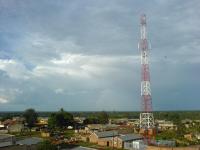
Cell Phone Tower in Uganda | Image Source: Uganda Bytes
At one time MPs in Uganda had begun addressing this issue to cub the increasing number of Cell Phone Towers propping up allover the country. However, the Cell Phone industry and their powerful lobbyists placed such legislation at bay. Yet this is a serious issue that Ugandans need to debate seriously.
While there is a Telecom boom in the nation and across Africa, the health consequences resulting from the Radiation of Cell Phones and numerous Cell Phone Towers in Uganda and Africa, will be a price that we shall pay. Yet the multinational corporations will not be around to deal with the effects…
Book On Ills of Mobile Phone Radiation Launched
All Africa | 7 November 2009Lagos state Commissioner for Youths, Sports and Social development, Prince Ademola Adeniji Adele has revealed that the inherent danger associated with use of mobile phones are mostly suffered by Nigerians especially Lagosians.
Speaking at a book presentation last Thursday, the Commissioner who was represented by Mr. Kayode Ogunleye commended the grand stride of the author Mr. Eric Edrems on the successful completion of his book entitled: Hazards of Mobile Phone Radiation
He further described the author as a worthy citizen who contributed immensely to sustainable development in our society by giving the greatest number of happiness to the greatest number of people through his book.
The book which focuses on the danger of mobile phone radiation to the health, also went further to suggest possible ways of preventing them
Although the health risk mentioned in the book are quiet revealing and scary, the author has started that the book is not aimed at raising panic in anyone, rather it is focused at educating the people on how well their phones can be placed so as to avoid such radiation hazard which emittes from their mobile phones.
Also speaking at the event, Mr. Christian Wogu, who chaired the occasion, drew the attention of participants on the duality of life and on the fact that there is always evil in good. He commended the author for not chosen to be at the rear and just take about the problems of GSM radiation, but has painstakingly proven himself to be a young man with exceptional qualities through the well concentrated research displayed in the boo k.
“It is not contestable that mobile phone has contributed greatly to us. It has made business thrive, conferences successful, etc. Mobile phone has done quiet a fortune to our nation. It has eased traveling and made loving easier. However, for it to continue to serve us better, we must heed to the caution made available in this book.” He said.
Similarly, the book reviewer, Dr. Boniface Oru also noted that although the author highlights basic hazards caused by mobile phone, he did not stop there as he proffers solutions to them. According to him, the quest for safety, good health of mind and body are the brain behind the book.
The book can be better described as a highly informative and resourceful material that addresses issues and provides solutions to mobile phone radiation as it affects all categories of user.
Relevant LinksIt is often not sufficient to embrace the benefits of mobile phones only, while we shy away from its inherent dangers.
While speaking on the need to support the effort of the likes Mr. Eric Edrems, the public relation officer of the Nigerian Institute of Safety Professionals, Mr. Odutola Akinlade has described the book as a safety measure, hence a must read for everyone . “Getting this book is not an extra cost. Its just like getting the helmet which every safety conscious person will not hesitate to have.”
As part of the highlights of the event, the Life Mirror Theater further thrilled the audience with an illustrative drama presentation, which drove home the points and health risk raised in the book.
Monday, November 2, 2009
10 Million US Dollars Wasted in Uganda’s Rural IT Project
Corruption continues to hinder progress in Uganda’s highly potential IT Sector…
Failed rural ICT projects eat up $10m in Uganda
The East African | November 2 2009Several rural communication projects that have so far used up more than Ush20 billion ($10 million) could fail with some districts complaining of huge maintenance costs.
At a recent district leaders ICT meeting in Kampala called to assess the first phase of the Rural Communications Development Fund (RCDF), it emerged that only 923 projects out of 3,863 that have been completed are still in operation countrywide.
Overall, however, the ambitious project that was meant to bring communication services to rural communities where telecommunication operators did not find it viable to invest, was supposed to roll out 4,786 projects during the first phase, which is ending soon.
Some achievements of the project include 71 Internet points of presence, 98 Internet cafes, 68 ICT training centres, 78 district web portals, 3,349 public pay phones, four research programmes and 43 ICT health projects.
The district web portals are meant to provide a communication link between local and central government.
However, districts are grappling with maintenance challenges and a number of portals are turning into white elephants, district leaders said.
“The costs of hiring and redesigning the web portals are very high,” said Kaberamaido district officer Stella Aringo.
For instance, it costs Ush600,000 ($300) per annum to hire a company to host the web portal, while designing fees range from a minimum of Ush1 million ($501) to Ush3 million ($1,503) annually.
The domain name, on the other hand, comes at an annual cost of Ush70,000 ($35).
However, the 78 districts receive fixed budgeted amounts, and portals — which often require redesigning — are never included in the allocations.
But RCDF director Bob Lyazi insists that the job of the Uganda Communications Commission is to set up the web portals and the districts to meet maintenance costs, a situation that district leaders say is not sustainable.
In the six years to 2008, the RCDF had accumulated close to $10 million, of which $6 million came from the one per cent levy on revenues of telecoms operators.
The leaders cite other costs too, like electricity.
“Power is a big challenge,” Arua district chairman Richard Ferua Andama said. RCDF was started in 2003 to provide access to basic communications services within a reasonable distance to Ugandans as well as to leverage investment in rural communications development, thereby promote ICT use.Since 2003, the World Bank and UCC have spent over $10 million in RCDF projects to bring communication facilities to rural areas that telecommunication companies deem unviable for investment.
UCC generates money through its one per cent levy on annual revenues of telecoms companies operating in Uganda as per licensing obligations.
Over the years, MTN, Uganda Telecom and Zain have contributed to nearly half of this investment in rural communications development, but district leaders are pushing for more.
With three other operators — Warid, Orange and I-Telecom — in the market now, it is expected that RCDF money will increase significantly.
Wednesday, October 14, 2009
ICT in Uganda Faces Tough Corruption Challenges
Despite the IT infrastructure, Uganda is still reeling back and forth from forces of corruption that are in no doubt hampering the would be robust ICT industry in East Africa…from nepotism, favoritism, power fights, mismanagement, greed, ICT in Uganda is yet to deliver, especially when it comes to helping the poor in Africa alleviate poverty,
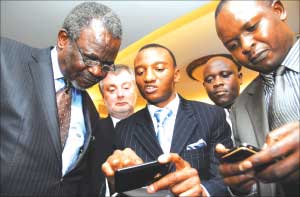
SEACOM’s John Mathwasa (centre) explains the network operation to Awori (left) and his state minister Nsambu Alintuma (right) -Image Scource: New Vision
diseases, and illiteracy… Current ICT Leadership in Uganda’s ICT ministry are so full of themselves that all they are concerned with are contracts for themselves and bogus middleman IT companies that would rake in profits to their bank accounts… The people of Uganda benefiting from ICT is still a dream…
What is really happening in the Technology ministry?
Richard Wanambwa |News | October 11, 2009Kampala
The Minister of Information and Communication Technology (ICT), Aggrey Awori, has halted the process of procuring a firm to manage the National Data Transmission Backbone Infrastructure and E-Government Infrastructure (NBI/EGI) project.According Mr Awori, the reasons for halting the process is based on the need for the involvement of National Information Technology Authority – Uganda (NITA-U).
“As you are aware, the National Information Technology Authority- Uganda (NITA-U) has been operationalised. The Board of Directors has been appointed and has already started carrying out their duties. The appointment of the Executive Director is being handled by the Board and the Minister. One of the key functions of NITA-U is to manage the government Information Technology (IT) Infrastructure including the NBI/EGI,” Mr Awori wrote to the ministry permanent secretary September 3.
He added “I am aware that the ministry has started the process of procuring a firm to manage the NBI/EGI. However, since NITA-U will be directly responsible for managing the NBI/EGI, it is essential that it participates in the process of procuring the said firm. Secondly, we need to rectify the damages that were caused on the optic fibre in Phase I in order to make NBI/EGI fully functional and in view of the above, I am asking you to halt the process of procuring a firm to manage the NBI/EGI on behalf of government until the two have been sorted out.”
However, Sunday Monitor, has learnt that Mr Awori on July 31 wrote to the manager Huawei Technologies confirming that his ministry had accepted Comtel Integrators Africa Limited, to be Microsoft partner in the NBI/EGI project .
“Further to our previous discussion and correspondence about Microsoft software for NBI/EGI, I wish to confirm that my ministry has accepted the nomination of Comtel Integrators Africa Limited to be the Microsoft partners in the NBI/EGI project, after the due diligence. You are authorised to start working with them expeditiously so that this project can be operational,” Awori wrote. But in choosing Comtel there are suspicions of conflict of interest because a senior manager at Comtel sits on the NITA-U board. Sources further allege that the ministry awarded this tender to Comtel in violation of government procurement guidelines that demand that such transactions be advertised.Last week, this paper reported that there was a fight for senior jobs at NITA-U with Mr Ambrose Ruyooka, a commissioner in the ministry, being dropped from the board. But Mr Awori last week dismissed the rumours that he sacked Mr Ruyooka saying “There is no evidence to show that I sacked him apart from a letter I wrote to him discontinuing him from National Information Technology Board. The truth is that Mr Ruyooka was on two boards…”.
Following our story, the ministry appointed Mr Andrew Lutwama as an interim chief executive officer of the authority. Mr Edward Baliddawa, former chairman of the ICT committee in Parliament but now an ordinary member of the same committee expressed dismay at what is happening in Mr Awori’s domain.
“What is contained in the reports is disturbing and of great concern to all of us in the ICT fraternity, but more so to all of those colleagues who did unreservedly contribute to the process of the successful enactment of the NITA-U Act 2008” Mr Baliddawa’s email posted on I-network, a social networking forum for ICT specialists and which this paper saw on Tuesday. He further noted that “after considering all the contributions, the House passed a law establishingNITA-U and gave specific guidelines as to the operationalisation of NITA. For example, the law is very specific on who should sit on the Board of NITA and how the Executive Director shall be chosen. The law specifies that among the 7 Board Members, the Ministry of ICT shall be represented by the Commissioner for IT.
When I read in the papers that Mr Ruyooka Ambrose had been appointed on the Board, my understanding was that he had been seconded on the Board on the basis that he was an Acting Commissioner for ICT in the Ministry. Membership on the board is on the portfolio he was holding and not as a person in the name of Ruyooka. I find it strange too; that the minister was never informed that Mr Ruyooka was on another Board although in the law this is not a basis for rejection.”
===============================================
Rift as IT Authority is set up
Richard Wanambwa | Daily Monitor | October 4, 2009Kampala
The composition of the new National Information Technology Authority (Nita) board members and the appointment of its top officials have raised eyebrows in the Information and Communication Technology ministry with some officials citing conflict of interest and favouritism, Sunday Monitor has learnt.The fight for senior jobs in the new Authority has already claimed its first casualty with Mr Ambrose Ruyooka, a commissioner in the ministry, being dropped from the board.
ICT minister Aggrey Awori told this newspaper that he removed Mr Ruyooka from the Nita board because he is already sitting on the Uganda Institute and Communication Technology (UICU) board. However, it is suspected that Mr Ruyooka was dropped in order to make room for one Dr Williams Ddembe, a former consultant in the ministry.
It is said Dr Ddembe is a business partner of the chairman of Parliament’s committee on ICT Nathan Igeme Nabeta. Mr Nabeta’s committee exercises a direct oversight function over Awori’s ministry thereby rendering the choice of Dr Ddembe open to suspicions of conflict of interest.
But Mr Awori denies suggestions of anything underhand.“There is no evidence to show that I sacked him (Ruyooka) apart from a letter I wrote to him discontinuing him from Nita. The truth is that Mr Ruyooka was on two boards; but for Dr Ddembe, he has not been appointed and we are going to advertise that job,” Mr Awori said in an interview.
Dr Ddembe and Mr Nabeta are business partners in a private ICT firm, Praxis Africa Limited. They reportedly established their interest through NBS Group Limited.According to documents available at the Registrar of Companies, copies of which Sunday Monitor has obtained, the three signatories to Praxis Africa Limited are Dr Williams Ddembe, Mr Nathan Igeme Nabeta and Mr Richard Basiime Bashenyi.
However, it emerged that after Mr Bashenyi landed a consultancy with the ICT ministry, Mr Nabeta and Dr Ddembe separately formed another company called Praxis Limited without the knowledge of Mr Bashenyi to do business with the ministry. Ministry officials got suspicious of this turn in their relationship with the company when an invoice was delivered to them from Praxis Limited, and not Praxis Africa Limited.
“I got a letter from ICT (ministry) inquiring how I billed them on a different letterhead, but on checking further I found out that Indeed, it was different, I later on discovered that my colleagues had registered a company called Praxis Limited and were soliciting for work using our original company but getting payment on a different account,” Mr Basiime said on Tuesday.
Last week Mr Awori defended Mr Nabeta saying: “Nabeta has no influence in appointing Ddembe and Ddembe has not applied yet but he (Bashenyi) did substandard work for the ministry. Let him settle their differences with Nabeta and Ddembe.”
Sunday Monitor failed to get a comment from Mr Nabeta as he was reportedly on a working trip outside the country. However, Mr Basiime said; “I have instructed my lawyers to get a court injunction on the activities of Praxis including blocking Shs120 million from the Electoral Commission where they used my company.” When contacted for a comment yesterday, Dr Ddembe said Mr Bashenyi was difficult to work with. “I am not a shareholder of that company but that guy is very difficult because he failed to come to court but above all I am not part of Nita group,” Dr Ddembe said.
Tuesday, September 29, 2009
High Speed Internet Still Out of Reach For Africans
Kato Mivule | Sept 29 2009
Despite the High Speed Broadband Internet Infrastructure in Africa, prices are still a major issue with opportunists seeking to make a quick profit. African corrupt and despotic leaders don’t offer any much help and it will only be quite some time before Africa actually benefits from the undersea Fiber Optic infrastructure… Cheap High Speed Internet will stay out of reach for Many Africans due to corruption, mismanagement, and lack of foresight, empathy, and concern by the African leadership…
Reduce Internet Costs | All Africa | Sept 29, 2009
Nairobi — When the undersea fibre-optic landed at the Kenya coast two months ago, there was high expectation that it would lead to efficient and cost-effective Internet connectivity. Although it is too early to make a critical assessment, consumers have no reason to smile yet.As we published in our business segment, “Smart Company”, yesterday, there is no trickle-down effect and by the look of things, it may a little longer before consumers reap dividends of expanded bandwidth and increased speed associated with the fibre-optic. Yet, prior to that, consumers were made to believe that the undersea cable would be the surest answer to encumbrances wrought by terrestrial connectivity.
Africa Undersea Fiber Optic Cable
With the slow pace of price change, experts and consumers are beginning to ask tough questions. Why can’t the prices go down? Are Internet service providers forming a cartel to keep the prices high? Maybe investors into Seacom and the East African Marines System can explain the variables at play. But one of the unspoken reasons is their desire to recoup their investment by keeping the prices high.
The essence of technology is to make life easier. This is what the fibre-optic cable was meant to achieve. Internet is a key driver of business, and since access has been made easy through the fibre-optic option, the service providers must just reduce costs for the end-users.
Tuesday, September 22, 2009
Telecom Sector Gets More Competitive in Uganda
Kato Mivule
UTL teams up with SEACOM and a sixth Telecom Company Launches in Uganda…However, There is so much Choice for Voice Services yet still Data Services are still lacking despite the current infrastructure… Looks like Ugandans have not yet bought into the ‘Data Services’ despite the transforming potential as Uganda’s footsteps…
The Managing Director of Uganda telecom Limited, Eng. AbdulBaset Elazzab has said Uganda telecom has partnered with SEACOM to offer improved services to its customers.
Elazzab says the partnership will help Uganda telecom to connect to the rest of the world via SUPER HIGH BANDWIDTH fiber optical through SEACOM.
According to the news release issued in Kampala today, the partnership will enable Uganda telecom to offer improved capacity and speed of internet access to customers.
UTL Logo
Elazzab also says Uganda telecom will connect to TEAMS and EASSY this month. He says the connection will enable Uganda telecom to have over 1Gbps capacity.
Elazzab says the connection will also significantly improve the company’s connection to the rest of the world and will result in a total enhanced customer experience.
The Chief Technical Officer of Uganda telecom, Reza Hosseiny says the capacity purchase by Uganda telecom on SEACOM network will modify the local internet market and that their company looks forward to a new era of true ‘broadband’ across the Great Lakes Region.
Reza says downtimes will be heavily reduced and customers will be able to do a lot more with their services such as video streaming, triple play, heavy down and uploads among others.
He says Uganda telecom will increase the broadband capacity to the company’s customers at no extra charge.
==================================================
Uganda Business News: Sixth Phone Company launches in Uganda
Ultimate Media | Sept 21, 2009The sixth phone company, I Tel Limited has been launched at Serena Hotel, in Kampala.
This brings the number of phone companies to six after MTN, Zain, Uganda Telecom, Warid and Orange.
The new phone company plans to invest over 300 billion shillings in Uganda.
Speaking at the launch, the company’s chief executive officer, Augustus Mulenga said the phone company will invest the money over the next three years.
He says the company’s investment will depend on conditions reigning at Uganda’s market.
iTel Logo
Mulenga says if the conditions are not conducive for their business the company will not invest all the money on the ground.
The chief executive officer says I tel is ready to compete in Uganda’s competitive phone business.
=====================================================I-Tel Uganda Plans $150 Million Network Expansion | Bloomberg | Sept 21, 2009
Monday, September 14, 2009
The Buganda Crisis, Technology, and Failure of Uganda’s News Media
Kato Mivule | September 14, 2009
The events that happened this past weekend in Uganda and in particular Buganda leave one to wonder what the future in Africa holds. It is sad that lives had to be lost just because the Ugandan Government felt it wise to restrict the movement of its citizens within their nation and chose to use extremely excessive force in stopping demonstrators who then turned violent as they saw their civil liberties being denied.
The violence of both Museveni’s Government and the Demonstrators was uncalled for. Yet still it is the Museveni Government that is to be held accountable for the 20 or so people who were killed because the Government forces opened fire directly at the protestors. The demonstrators were unarmed and in no way did they warrant such deadly force.
It is therefore serving that Global Governments especially in the West call Museveni’s Government to account. There is no reason at all why Museveni ordered the killing of 20 innocent unarmed demonstrators. One fears that Uganda is slowly and quickly turning back to the Idi Amin – 1979 Era.
Uganda’s government did not find it satisfactory to shoot and kill innocent unarmed people but chose to have a News Blackout by closing many Radio Stations, TV Stations and arresting and torturing many in the Media who were simply doing their Job to report the news. President Museveni claims that the Media was inciting Violence, a charge he cannot and will not sustain in Ugandan Courts of Law. For Uganda’s Judiciary has never been friendly to Mr. Museveni and the next ‘war of riots’ will be between Museveni and the Judiciary as the Uganda’s Activist Judges throws out most of the cases.
However, the issue here insofar as technology is concerned is the deliberate failure of Uganda’s News Media to hold Mr. Museveni accountable by employing Technology to report news to the outside world that in turn would put pressure on Mr. Museveni to stop brutalizing and killing his own citizens.
It is as if Uganda’s News Media did not learn anything from the Iranian Crisis in which local citizens kept news flowing to the outside world despite the ‘Media Blackout’ by the Iranian Government.
Don’t get me wrong, I am not encouraging anyone to riot; my issue is with reporting news. There is absolutely no reason why we should be kept in the dark concerning what is happening in Uganda in the age of Technology and the High Speed Internet.
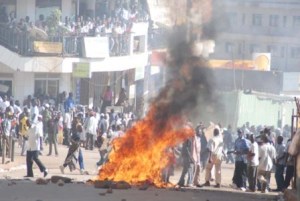
Buganda Crisis Riots| Image Scource: Daily Monitor - Kampala
Take for instance CBS FM the Buganda Radio Station that was taken off Air, they used to have a website years ago but they don’t even have a Free Blog that they can post news that they directly source and collect. Another radio is KFM which belongs to Monitor Newspaper; they don’t have any web presence at all. It is only Radio Saptienca with a live stream and Website but no Twitter Account and no Face Book Account.
It was only Independent Magazine by Andrew Mwenda that tried to keep the rest of the world updated by what was going on in Uganda and thanks to www.twitter.com/#kampala among other twits, news kept flowing.
Monitor Newspaper tried but failed and seemed to faze out news updates when the reporters went to sleep.
Yet CBS FM which has an audience of over 10 Million Listeners should have been proactive and invested in a website or at least a free Blog page that they could employ to update their listeners in Uganda and also the huge Baganda and Ugandan Following in the Diaspora.
There is no reason why CBS FM does not have a Twitter page and FaceBook Account. There is no reason why CBS FM does not at least post news updates and Podcasts on Free hosting sites such as YouTube etc, most of these services are free and with the money that CBS FM generates, they can employ a Techie to oversee such assets.
Even if CBS FM was shut down, Mr. Museveni cannot shut down the Internet…that is way beyond his “intellectual” and physical capabilities of the gun…President Museveni cannot arrest the Internet…
I hope CBS FM learns from this lesson wakes up. If Buganda and Mengo wants to win the Media War between them and Mr. Museveni, then they must embrace Media Technology and stop relaying on Analog FM Broadcasts alone as the way forward.
Yet still even tech savvy Media Outlets like NTV and WBS TV still failed greatly at keeping the world informed at what was happening in Uganda, NTV used to post news updates on YouTube but stopped. The NTV website is never updated and since they work hand in hand with Monitor Newspaper, then they had better aggregate news on their site. Not even NTV has a Twitter account.
WBS TV tries to aggregate Ugandan news on their website but often the site is never updated and one finds news that is three month old and no new information. The goal of the Media should be to report news and hold African despotic leaders to account using today’s Technology and becoming creative at it. Simply crying foul that Museveni has shut down Radio Stations is not enough.
It is high time that Uganda’s Media fully embraces Technology, get reporters Blackberries, iPhones, and Google Phones and perhaps Mr. Museveni will think twice before brutalizing, shooting, murdering, and killing his own citizens who freely exercise their right to demonstrate unarmed next time.
Wednesday, September 9, 2009
Fiber Optic Cable Reaches Nigeria
Kato Mivule
Nigeria decides not to be left behind in the race to connect Africa to the Fiber Optic Super Infor Highway… If serious and avoids the sins of corruption, Nigeria could well position herself as ICT Powerhouse in West Africa…however, this is yet to be seen. It seems that Africa is being flooded with investiment in IT but will Africans take advantage of the ICT Infrustructure? The Articles Below give another picture…
Globacom Cable Reaches Lagos IT News Africa | September 8, 2009
The $800 million Glo 1 undersea cable has landed in Lagos. The landing of the submarine cable in Lagos makes Globacom the first single operator to successfully link submarine cable from the United Kingdom to Nigeria, a project that is designed to crash telecom prices and make bandwidth abundantly available.
This event is historical because it is the 1st time that a single company has embarked on such a projoct on the continent. The trend in the global telecommunication industry is for a consortium of companies or even nations to combine resources to build submarine cables as was the case with the SAT submarine 3 cable which was built by a consortium of 36 countries.
With the successful landing of the submarine cable in Lagos, Globacom says it will likely commence commercial operation after the commercial launch in 6 weeks time.
East Africa: The Cable is Here But Region is Not Ready for It All Africa | Sept 7, 2009Nairobi — East Africa may have received the first undersea fiber optic cable a month ago but it is emerging there is no requisite infrastructure to enable Seacom go deeper into the hinterland.The EastAfrican has established that in Kenya and Tanzania — on whose coastlines the cable was simultaneously switched on in Mombasa and Dar es Salaam by Presidents Mwai Kibaki and Jakaya Kikwete respectively — faster Internet connectivity still remains out of reach while landlocked neighbours relying on the two countries for connections could even take longer to experience broadband connectivity.According to Africa Online, one of the ICT firms linking consumers to the fibre-optic cable, Kenya, the region’s natural highway, has only one terrestrial link to the undersea cable — the one operated by Kenya Data Network (KDN) — which is already overwhelmed by traffic, leading to uneven connection speeds.Africa Online general manager in Kenya, Ken Munyi, said that due to high traffic, the country requires at least three links so that in case one jams, providers can switch to the next seamlessly.Until that happens, the providers may have to invest in back-up satellite capacity and pass additional costs to users”, he said.Africa Online has operations in Kenya, Uganda and Tanzania.Last week, The EastAfrican talked to its regional managers, who were in Nairobi for a company conference, about why the landing of the fabled fibre optic cable whose arrival is yet to make a difference in either pricing or speed.Mr Munyi said the experience of his firm had brought into focus the unpreparedness of the region to embrace the technology, which was launched with so much hype that consumers had come to expect not only faster telecommunications but cheaper too. Unfortunately, the consumers did not realise that there is more to the cable than landing in Mombasa.“Development of in-country telecommunication infrastructure, local content, growth and appetite for services other than browsing and e-mail, and regulation aimed at enforcing competition and ensuring the quality of service are all critical if the region is to realise the effect of this important development,” Mr Munyi said.He said the existing IT security systems need to be alert to the dangers inherent in the new broadband era.“It is perhaps time we qualified the benefits to the different players and articulated what is achievable now and what will have to wait till the necessary infrastructure is in place,” he said.Critical here is last-mile connectivity — the link between the user and service provider. Applying the analogy of “a chain is only as strong as its weakest link,” it becomes apparent that despite connecting to the fibre at the landing point, the other components of the network are weak, unreliable and insufficiently supported.“The international cable system, national cable system and last-mile link must all be optimised to deliver quality services,” Mr Munyi said.In Tanzania, said Africa Online manager Stanley Ayittah, despite the switching on of the cable, things are yet to move since the in-country infrastructure — the metro-ethernet — is not ready.Telekom Tanzania, which undertook the responsibility of delivering the technology to users, is yet to switch the metro-ethernet and has not made public when it will do so. But testing is said to be going on.Mr Munyi, however, said that Kenya is way ahead of its neighbours — already Internet speeds have picked up. He added that once the other two terrestrial links come on board, things would improve.These links are expected from Orange and Jamii Telcom. While Orange is reported to have its infrastructure ready for the link, it is waiting for The East African Marine System (Teams) cable, in which it is a shareholder.The Teams cable is expected to land in November, when both Jamii and Orange will switch on their links, giving providers and users the much-anticipated increase in bandwidth and speed.The Africa Online managers also said that regulators have to adjust frequency policies to enable wireless networks to carry more capacity. Limiting frequencies to 15MHz will result in networks that cannot be optimally fine-tuned to meet market demand.By limiting the frequencies, a Wimax network that is manufactured to support throughputs of 80+mbps (megabits per second) is limited to, say, 20mbps.In the short-term, limited satellite bandwidth will be retained for redundancy in case of fibre-optic cable failure.The region, Mr Ayitta added, is in its infancy with regards to the access to the fibre and it is too early to compare it with West and Southern Africa, that were hooked up five to six years ago.Throughout the region, Africa Online’s regional managers say, most of the investment in last-mile connectivity is concentrated in the large urban areas, where majority of the current users reside.The GSM players and fixed national operators have attempted to expand data services to rural areas and though these services may not be the same in all areas, they are a step in the right direction. Initiatives such as “ICT Villages” will also play a role in taking the services to the masses.But unless there is direct government investment in opening up such villages, investments in different areas will remain driven by market forces.Governments need to embrace ICT as part of the regional development agenda, as an enabler of policy implementation in all sectors — agriculture, security, health, public services, and education.Players in the region also need to work hard at local content generation to stimulate demand for connectivity.
Thursday, August 27, 2009
Rwada Gets Proactive with Broadband Internet
Kato Mivule
While Uganda struggles with corruption, lack of political will, and largely lethargy among the Top ICT Officials in the ICT Ministry, Rwanda is moving on very fast to fully utilize the SEACOM Fiber Optic Cable. Rwanda knows that this infrastructure is imperative to her Economic Stability, Growth, and even National Security Interests…
Uganda, Rwanda firms get piece of optic cable
Daily Monitor Correspondent |Nairobi | 27 August 2009Uganda Telecom and Rwandatel have purchased up to 620 Mega bytes per second of capacity on the Seacom fibre optic cable and secured links from the landing point on the Kenyan coast through to Kampala and Kigali.
The partnership between Seacom, UTL and RTL now extends international connectivity from the undersea cable throughout East Africa.The link to Rwanda has been made possible after Seacom secured rights to use the terrestrial networks constructed by the two players between Kampala and Kigali.
Under the terms of the deal, UTL and RTL, both subsidiaries of the Libyan Africa Portfolio LAP Green Networks will have immediate access to the Seacom capacity.
Whilst Uganda has been connected to the network since its commercial launch on July 23, Seacom CEO Brian Herlihy expects Rwanda to benefit from the broadband capacity starting next month.
Rwanda ICT Center - Image Source: http://ictpark.rita.gov.rw/index.htm
“This development is in line with Seacom’s objective to provide connectivity solutions to landlocked countries across the East and southern African region,” said Mr Herlihy.
“The capacity purchase by Uganda Telecom will dramatically modify the local Internet market,” said Mr AbdulBaset Elazzabi, LAP Green Networks and Uganda Telecom Ltd MD.
Mr Patrick Kariningufu, chief executive of Rwandatel said; “we are excited about our deal with Seacom and look forward to delivering affordable broadband to our customers.”
Tuesday, August 18, 2009
Uganda: National Fibre Optic Backbone Project
Analysis
The National Fibre Optic Backbone Project has recently been the discussion topic in the Parliamentary Committee on ICT and the Ministry of ICT where clarifications on the project were sought. There is evident need to articulate what the project is about, what it means to the country and the region together with a clear understanding of the technology and related financial aspects.

Dr. Ham Mulira - Uganda's ICT Chief
In the current business environment, Information Systems, the Internet and global communication networks are creating new opportunities for organisational coordination and innovation. Such systems, used in government/governance, can extend reach and effectiveness of both to remote locations, and improve service delivery to citizens. Current practice has been satellite based communication links, but the associated costs are prohibitive and result in minimised access size of paths, (bandwidth) leading to slow Internet speeds, for example.
In order to address the above, the government of Uganda, through the Ministry of ICT, decided to implement the National Data Transmission Backbone Infrastructure and e-Government Infrastructure (NBI/EGI) project for high speed communications. This entails laying of Fibre Optic Cables and installation of related equipment, which include switches, optical transmission equipment, data communication equipment, fixed network equipment, video equipment, computers, servers, training and service.
Ultimately, the fibre optic cable will link Uganda to the submarine cables on the East African coast providing access to the rest of the world through Kenya. The project has two key components namely-, the National Backbone Infrastructure (NBI) and the e-Government Infrastructure (EGI), to be implemented in three Phases at a total contract cost of $106m.
Phase I was for e-Government Infrastructure and its objective was to provide connectivity to government ministries and departments including high-tech communication services called TETRA for Uganda Police with a total cost of $30 million. It should be noted that this component was designed for internal government use, commonly referred to as Government-to-Government services and not for general public usage. Since the phase was to connect ministries, only Kampala, Entebbe, Jinja and Bombo were connected with a total distance of 168 km of laid fibre and related equipment.
Phases II and III of the NBI constitute the remaining areas of the country (see map figure 1) including establishing a high tech government data centre. A backbone is like a digital highway or main road, it covers enough locations strategically spaced across the country from which links can be established to serve the surrounding areas.
Similarities can be drawn with the telecommunication masts strategically located to establish communication signals that serve the surrounding areas. You do not have to stand near a telecom mast to make a phone call. The NBI is intended to ensure availability of high bandwidth data connection across Uganda at reasonable rates and can be used for government service delivery, schools, hospitals, businesses, homes and ultimately the general public. When mobile telephones were introduced, the costs and services were unaffordable to the majority.
As the technology evolved and infrastructure spread, a dramatic cost reduction led to increased affordability by the public with over nine million customers today. In addition, a variety of innovative services using the mobile phone have been introduced. Similarly, when the submarine cables are linked to the NBI there shall be widespread availability of high speed communications at a fraction of current costs leading to Internet and related services being affordably accessible to the public. Phases II and III shall cover 1,900 kms at a cost of $61 million and $15 million, respectively.
In planning, designing and sizing a national backbone project many factors have to be considered. These include the terrain, geographical spread/coverage, fibre capacity to meet potential demand based on size of the target population, costs of civil works amongst others. For example, laying 10km of fibre in the countryside is quite different to laying 10km of cable in the built-up urban areas.
In terms of geographical spread/coverage, the technology used to cover communication signals over a long distance between sites is different from that across areas that are nearer to each other. In comparison, the electric wire for a light bulb hanging in a room is not what determines the intensity of light emitted, it is the power of the bulb that does so, hence, a wider room requires higher wattage/power. The demand in terms of numbers of potential users determines the power of the fibre cable in terms of traffic it can handle simultaneously. It is, therefore, erroneous to simply compare costs of one project to another without considering a multitude of factors.
In the discussions, direct comparison of costs between the Uganda project and that of Rwanda were made asking why the Ugandan one is $126 million for 2,100 kms and the latter $38 million for 2,300 kms (in some reports it is 1,300 kms).
First, the contracted cost of the Uganda project implementation for the laying of the fibre, equipment and training, inter alia, as per the loan, has a total of $54 million for the e-Government component ($30 million in Phase I and $24 million in Phases II & III) and the National Backbone Infrastructure is $62 million totalling to $106 million. The additional $20 million is counterpart funding by government, which includes taxes and clearing.
As per standard practice, taxes are always budgeted for in government procurements, although they are not actual physical money paid out, they are accounting book entries. The figure of $38 million for the Rwanda project, which has been continuously reflected in the discussions is the contract cost and may not reflect the other costs such as taxes and clearing. The comparison should strictly be on the NBI components which is the $62 million against the $38 million since the Rwanda project does not include the e-Government infrastructure component.
National backbone projects are designed to cater for current and future needs of the country for several decades since once the fibre is laid the traffic capacity can be increased by changing the devices that send the traffic not the fibre. In the light bulb wire example, it is like changing to a more powerful light bulb not the wire. The cable capacity is the amount of traffic, which it can handle simultaneously and it is measured as the number of signals per second or Bits Per second.
Each country bases its requirements on the potential demand, which is determined by the size of population and geographical spread. Consequently, the technologies used are different. In Uganda, because of the relatively larger geographical spread and a larger population with potentially higher traffic demand, there is need to send signals across sites, which are relatively far from each other whilst catering for higher traffic.
For example, a signal from Kampala to Gulu, which is about 330kms requires more intermediary “boosters” to ensure that the signal does not lose strength. The fibre cable laid is 24 core or strands of fibre and in Uganda the technology for the stations is largely what is called Dense Wavelength Division Multiplexing (DWDM), which combines and transmits multiple signals simultaneously using the same fibre, in effect, transforming one fibre into multiple virtual fibres increasing the capacity of the physical cable.
This technology has a traffic carrying capacity of 2.5 Gb/s or two and a half billion signals per second on one fibre strand. The alternate technology is called Synchronous Digital Hierarchy (SDH), which has a capacity of 155.2 million signals per second. In other words, DWDM has 16 times more capacity. The current population in Uganda is about 30 million and estimated to rise to over 40 million by 2017 according to the Uganda Bureau of Statistics with a wider geographical spread. There is, therefore, more need for the DWDM technology, hence, relatively higher costs.
Another aspect of the discussion is the cutting of the cable. In laying fibre cable, just like other projects with routes on main roads, certain standards are set including the distance off the main road and depth of the cable. Implementation of the NBI coincided with major road works along certain routes, especially, Jinja and Bombo roads leading to cable being accidentally cut in some cases.
This issue was addressed through joint coordination between the Ministry of ICT and the Ministry of Works and Housing together with relevant agencies but the problem would still re-occur on ground but systematically resolved. However, the NBI was designed with Resilient Packet Rings to ensure that should a breakdown occur, the traffic can automatically be re-routed.
In conclusion, the NBI/EGI project is vital in preparing the country for full participation in the new Information Age. All countries in the region are at various stages of implementing national backbones which will ultimately link into each other for regional communications connectivity. As in any project, it has had expected setbacks but these would continue to be addressed and resolved.
A comparison based on total project cost divided by total distance is misleading as has been portrayed above. The Table shows a comparison of submarine cables being built on the east coast of Africa. In fact, using such an approach leads to known costs per km ranging from $15,000 to US$ 500,000 per km depending on location, from a countryside project to New York City.
It is unfortunate to state that costs were inflated a conclusion based on a simple comparison of two project costs. Not only is this categorically untrue but also makes one wonder how such statements can be made with impunity totally disregarding the significant contribution of a number of people who have played roles in a professional and transparent manner to make this project a success.
Uganda was the first in the region to implement the e-Government Infrastructure with voice, data and video communications across government and delegations from many African countries visited the project to understudy it. In other countries such national achievements are recognised with pride and built upon not ridiculed, we should always endeavour to objectively assess such matters in the task of national development.
The writer is the Senior Presidential Advisor on ICT
Broadband for Uganda: The inside story
Wednesday, 05 August 2009 | By Joe Powell | The Independent
July 23, 2009, 159 years after the world’s first submarine cable was laid, will go down in history as the day East Africa became fully connected to the world’s digital super-highways. Seacom’s cable, 17,000km long and costing $650 million, is now officially ‘live’ with a capacity of 1,28 Terabytes per second, the equivalent of hosting two million international phone calls simultaneously.
Unsurprisingly hyperbole was not on short supply at the launch event. Cisco’s representative announced, “We will change the way Africans work, live, learn and play with the rest of the world”. Seacom CEO Brian Herlihy urged the African youth to wake up every morning asking them “are we dreaming big enough?” An excitable Tanzanian President Jakaya Kikwete, speaking from Dar es Salaam live via video link, declared his country ready for “e-commerce, e-government, e-everything”.
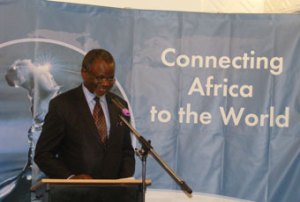
Aggrey Awori, Minister of ICT speaking at the media launch of the SEACOM cable, on July 23, at Serena Hotel Kampala. INDEPENDENT/ BOB ROBERTS KATENDE
However, a series of revelations have come to the attention of The Independent that threaten to take the gloss of this indisputably momentous time for telecommunications in Uganda.
The first concerns the role of Ugandan Internet provider Infocom, who alongside their sister company Kenya Data Network (KDN) have managed to secure the only fibre optic cable running from Mombasa to Kampala. Altech Stream Holdings Ltd, a South African company, took a majority stake in Infocom and KDN in March last year. However, while KDN laid their own cable from Mombasa to Malaba, Infocom is leasing the Malaba to Kampala section from the Uganda Electricity Transmission Company (UETCL), a government power utility. UETCL laid the cable primarily for power purposes, but have begun leasing out excess capacity to telecoms companies.
However, confusion has arisen over whether UETCL’s cable is being considered part of the National Data Transmission Backbone Infrastructure (NBI), a government project. The NBI blueprints include laying a cable from Kampala to Busia, an apparent duplication of government expenditure given the UETCL cable. The CEO of UETCL Eriasi Kyemba told The Independent that while they couldn’t agree to an ICT Ministry takeover of the cable, they would consider a leasing arrangement if approached.
Infocom’s grip over Uganda’s use of the Seacom cable is further strengthened as they have been appointed the hub provider for the country, what is known as a ‘backhold provider’. This means that companies seeking to buy bandwidth capacity will have to negotiate with Infocom, currently the only company to have a contract with Seacom. A telecoms insider talking to The Independent said this brings in clear competition concerns as Infocom are also planning to provide Internet services to consumers. While ICT Minister of State Alintuma Nsambu rejected this arrangement as clearly “not allowed”, Infocom CEO Hans Haerdtle defended his company’s position as “no different to what other countries have”. Haerdtle said he saw no problem with “Infocom competing with other operators while being a backhold provider” and cited infrastructure-sharing agreements with rival companies as evidence they could be reasonable. The Independent has learnt, however, that Infocom will be retaining exclusive rights over the countrywide network of 16 WiMAX sites, which will be able to utilise the faster Internet via microwave even while the NBI remains incomplete.
Infocom have been fortunate that rivals such as MTN and UTL invested in an alternative submarine cable, Eassy, which is running behind schedule and will not go live for at least a year. Both MTN and UTL have a superior fibre and copper network countrywide but without a deal with Seacom are in danger of being left behind.
The third submarine cable, Teams, has docked at Mombasa and is now undergoing final testing. Teams have significant investment from the Kenyan Government. Sources have confirmed that telecoms companies in Uganda are now scrambling to buy bandwidth from Seacom and Teams directly, with one senior executive telling The Independent anonymously that there is no way they would tolerate working through Infocom.
Issues surrounding the NBI are another clear concern for those wanting to take advantage of Seacom’s cable. Seacom’s representative in Uganda, Fred Moturi, told The Independent that the government would be largely responsible for laying cable to remote parts of the country, as it is unlikely the private sector would find it profitable. Currently the government has only completed cable from Kampala to Entebbe, Bombo and Jinja. “It’s almost like people never believed this would ever come to the East coast because there have been so many attempts and false starts” Moturi said. The 2,130km $106 million NBI plans in place would, though, cover a large chunk of the country, with Minister for ICT Aggrey Awori claiming the second of the four phases would be finished by the end of the year. The cost of the project has raised questions given that Rwanda was able to lay 2,300 km of fibre cable at a cost of $38 million. The company that won the Uganda contract, Huawei Technologies, donated $2 million worth of communication equipment during the tendering process. Analysts at the time speculated that this may have been contrary to the principles of a fair tender.
Information obtained by The Independent also shows that Moturi’s fears are well founded. Cabinet documents show that the government has no money for phase IV of the project, leaving over a third of the country out of the fibre revolution. The phase IV cable is designed to stretch from Mbale through Kapchowa, Moroto, Kotido, Kitgum, Gulu, Adjumani, Arua, Nebbi, Pakwach and rejoins the network in the Amuru region. Some representatives of West Nile region said this is further evidence of government marginalisation of northern Uganda.
Areas that will be connected to the NBI are likely to witness improved economic development. Alongside business development, improved connectivity has huge potential in the education and healthcare sectors. In preparation for the cable’s arrival upcountry Nsambu said that all government secondary schools will have IT laboratories by the end of the year. For Uganda as a whole the arrival of Seacom’s capacity, which will be joined by rival submarine cables Teams and EASSy within the next year, means the country will be able to compete with South Asia in areas such as call centres, business outsourcing and software development. A recent World Bank study found that for every ten percentage points increase in connectivity a country can expect a 4.6% increase in exports and a 1.3% bump in GDP. The business community, who currently pay in the region of $5000 per megabit per month to access the Internet by satellite, will also welcome the reduced costs.
In comparison Seacom wholesale at between $50-150 for the same access, although with Infocom taking their cut the retail price is likely to be higher.
The Independent has learnt, though, that there is another risk to Uganda’s digital future. Currently there are no plans in place to build a second link to the Mombasa landing sites of the three planned submarine cables. Uganda’s over-reliance on links through Kenya has been exposed twice in recent years, with the fuel shortages of January 2008 after the Kenyan election violence and the tearing up of the rail link by thugs in Kibera over the Migingo island bilateral dispute. Nsambu revealed that the satellite infrastructure would be kept in place as a back up in case of any interruption. President Kikwete also announced plans for terrestrial cable to run from Dar es Salaam to Burundi, Rwanda and Uganda, although no timescale was placed on the project.
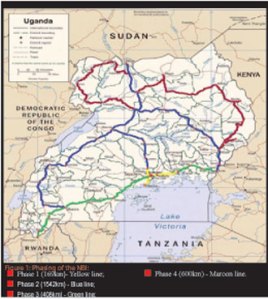
Uganda's Fiber Optic Cable Layout
The ICT Ministry is planning a new Bill to address some of these issues, with Awori promising it will be tabled within 45 days. According to Nsambu the Bill seeks to provide the necessary regulation to ensure that the Uganda Communications Commission (UCC) can effectively manage the new services.
The ministry itself has been the subject of speculation over whether it has the funding and personnel to effectively run the country’s ICT sector. At the last budget it received only Shs6.5 billion, by far the lowest allocation of any ministry and amounting to 0.1% of the government’s total spending. This is partially offset as the UCC is supposed to take 1% of the profit of each telecoms company, the majority of which is directed at ICT in government schools. The appointment of Awori as the cabinet minister for ICT also raised eyebrows in the industry, with the popular and knowledgeable Ham Mulira shifted to presidential advisory duties.
Despite the complications uncovered by The Independent this should remain a time for optimism in Uganda’s ICT sector. The arrival of high-speed Internet will revolutionise the way of doing business for those able to use it. However, until questions of ownership, security, upcountry access and the role of Infocom are cleared up, there will continue to be scepticism over the extent of the benefits Ugandans will receive.
Monday, August 10, 2009
$1M Corruption and Negligence Scandal hampers IT Development in Rural Uganda
Kato Mivule
Corruption, negligence, and a lack of accountability are hampering Uganda’s growth in I.T and will certainly make Uganda lose her place as a regional I.T power in the East African region. With many IT folks unemployed and under employed, Uganda’s government cannot put together a project worse even accomplishing a simple IT project like setting up a Computer Resource Center in a rural area…
Another $1m Internet project in jeopardy
Daily Monitor | News | August 9, 2009 | Yasiin MugerwaCorruption and negligence has bungled a planned $1 million government rural Internet project seeking to establish business information centres in the countryside communities, MPs heard last week.
Angry MPs on the Information and Communication Technology Committee, also gave the sector minister, Aggrey Awori and his junior colleague Alintuma Nsambu, 48 hours to explain why the costs of a $126 million (about Shs252 billion) National ICT backbone infrastructure project were reportedly inflated.
“The new District Business Information Centres (DBICs) Project has flopped due to negligence and corruption. These people in the ministry have turned this project into a conduit for them to waste public money,” Mr Ssebuliba Mutumba (DP, Kawempe South), one of the committee members said yesterday.
“They supplied computers and other equipment to various districts, but were not connected, no testing done, no mini-servers and have been deserted on the floors with dust yet we spent billions. We are yet to get the explanation why they inflated costs of the National ICT backbone and here we are with another project mishandled the same way and the ministry is doing nothing.”
The uncertainty over the new rural Internet project puts the ministry’s credibility in spotlight after Daily Monitor reported two weeks ago that the same Committee had queried the $126 million cost for the 2,130km project national ICT backbone project, arguing that Rwanda is carrying out a similar project across 2,300km for only $38 million (about Shs76 billion). To substantiate their claims, the MPs showed Mr Awori and his team, footage of the neglected equipment, idle at various centres in the districts of Mityana, Iganga and Busia. Other districts which were supposed to benefit from the project include; Kamwenge, Lira and Rukungiri. After viewing the “footage of shame” as the MPs described it, minister Awori, who only came to the ministry in the February Cabinet reshuffle, apologised to the committee. The post was previously held by Mr Ham Mulira.
“We sincerely do apologise to the committee, the contractors who won the tender didn’t play their role and as a ministry, we are going to take action to correct these faults. There should have been a follow-up but this wasn’t done.”
Some MPs led by Ishaa Otto (UPC, Oyam South) cited duplication in the project under scrutiny after it emerged that the establishment of District Business Information Centres is closely linked with the e-government initiative, which was covered under the disputed National ICT backbone project.
“We welcome the idea of the rural ICT project, but this is covered under the National ICT backbone. We are talking about Shs2 billion going to waste and all this is duplication intended to abuse public funds,” Mr Otto said.
“We have given them 48 hours to give us all the information relating to these two projects otherwise we see corruption and negligence pulling us down yet we need ICT to develop as a country.”
Once the project succeeds, DBICs shall be the first of its kind as a government response to the challenge of enhancing productivity and fighting digital marginalisation.
The Committee has ordered Mr Awori to appear before it on Thursday with a written explanation as to why the rural internet project has delayed and who was responsible for the supervision of the project.
Tuesday, August 4, 2009
Corruption a setback for Uganda’s Broadband Internet
Kato Mivule | August 4, 2009
Uganda’s Broadband future and hopes for Cheap High Speed Internet hand on a shoe string after the Ugandan Government could not account for funds used in the ‘Phase One’ for the High Speed Fiber Optic Cable Infrastructure.
Uganda’s Legislative Body has refused to release funds for the ‘Phase Two’ of the project citing graft and lack of accountability.
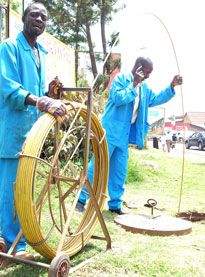
Telecom Workers Laying Cable in Kampala - Photo Source: Daily Monitor
The worst fears is that even when the High Speed Fiber Optic Infrastructure is fully complete, Ugandans might never get cheap High Speed Internet as Government Officials will seek to setup fake middlemen companies that will even make it harder for poor folks to access Broadband Internet.
As usual when Uganda takes three steps forward, they regress and take another four steps back courtesy of Uganda’s Government officials who seem to have no remorse and sense of decency…
Inflated costs set to delay faster Internet
Daily Monitor | News | August 4, 2009 | Yasiin MugerwaUgandans may have to wait longer for the broadband revolution after Parliamentarians refused to approve Shs122 billion for the second phase of a countrywide Information and Communication Technology (ICT) backbone infrastructure project, citing corruption and inflation of costs in the first phase of the project.
Legislators on the ICT Committee of Parliament last week questioned the $126 million (about Shs252 billion) cost for the national ICT project, arguing that Rwanda is carrying out a similar project across 2,300km for only $38 million (about Shs76 billion).
“We want the Auditor General to look at the cost of this project. Otherwise, Uganda cannot spend more than Shs252 billion yet our neighbours in Rwanda and Kenya are spending less amounts on a similar project,” Mr Ishaa Otto (UPC, Oyam South), an ICT committee member, told Daily Monitor on Friday.
The development comes barely a month before Uganda upgrades its Internet communication speeds to levels enjoyed in Europe, the Middle East, the Far East and now Kenya through undersea cables providing broadband technology.
Experts expect broadband, which refers to high data rate Internet access, to reduce the cost of Internet bandwidth by up to 70 per cent. The legislators have also summoned ICT Minister Aggrey Awori to provide a detailed account of how the Shs60b budgeted for Phase I of the project was spent.
The 2,130 kilometre project aims to speed up e-governance by providing a basic communication link to rural communities and improving service delivery in key areas such as health, education and agriculture.
In an interview on Saturday, Mr Awori said, “We didn’t inflate any costs. The comparison with Rwanda doesn’t arise because for us we are dealing with excavations and laying the cable at the same time. This makes the costs higher than that of Rwanda and we are different.”
According to project details obtained by Daily Monitor, Phase I was budgeted at $30 million (about Shs60b), Phase II at $61m (about Shs122b) and Phase III at $15m (about Shs30b) with an additional $20m (about Shs40b) budgeted as government counterpart funding.
After spending Shs60b for Phase I in the 2007/2008 financial year, the government has requested Parliament to approve an additional Shs122b to start Phase II. But MPs led by Chairperson Mr Nathan Igeme Nabeta have blocked more funding to the ICT project until the ICT ministry accounts for the Shs60b spent under Phase I.
The first phase of the project covered Kampala, Entebbe, Bombo and Jinja. Although it was completed last year, MPs who carried out a field visit on Wednesday found that only the Kampala site is operational.
Mr Otto reported that when the committee visited the project sites in Kampala, Mukono, Jinja, and Bombo last Wednesday, it saw nothing but corruption at its best. “After spending Shs60b budgeted for Phase I, there is nothing to show on the ground. The new fibre cable linking Kampala to Mukono and Jinja was cut off, the inter-connection centres were non-operational with no power and the generators were missing,” said Mr Otto.
The Director of Communications and Broadcasting Infrastructure in the ICT Ministry, Eng. Godfrey Kibuuka, who represented the ministry during the tour, reportedly failed to explain why the Mukono, Jinja and Bombo sites were not working. Eng. Kibuuka could not also explain the alleged inflated costs of the project.
Mr Awori told Daily Monitor, “We got problems with connections because our cable was cut at Namanve but we are handling this matter.”
Mr Nabeta said, “We appreciate the need for this ICT backbone, but we cannot approve more money without explaining what happened with the $30m for phase I. We want this project to succeed and we want the faults to be corrected.” But Mr Awori retorted: “It is not true that there is no value for money because 90 per cent of the e-government facility is functioning. It is only the commercial part which is not working because we are yet to connect to the sub-marine.”
